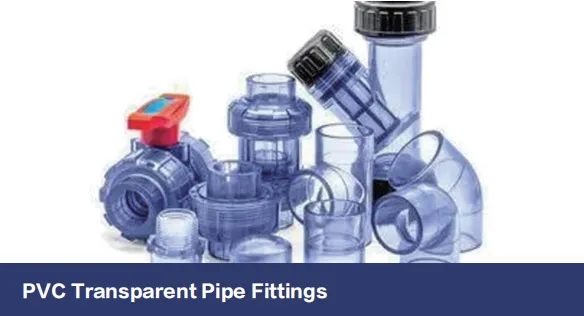
In-depth analysis: The excellent chemical corrosion resistance of PVC transparent pipe fittings

Imagine working with plumbing systems day in and day out. You're constantly wrestling with materials that rust, corrode, and fail when exposed to everyday chemicals. But what if there was a solution that could handle aggressive chemicals while letting you see what's happening inside? That's exactly where PVC transparent pipe fittings change the game. Unlike metal pipes that degrade over time, these see-through champions offer incredible durability against the harshest substances while giving you visual access to fluid flow – a technician's dream.
The Material Science Behind the Magic
PVC (Polyvinyl Chloride) isn't your average plastic. At a molecular level, it's got this incredible stability that comes from its carbon-chlorine backbone. Picture tiny molecular shields that repel chemical attacks. When manufacturers make it transparent, they're essentially polishing it to optical clarity while preserving those protective qualities. It's like giving chemical warriors a crystal helmet.
Why UPVC Takes it Further
Now, when we talk about unplasticized PVC (UPVC), we're dealing with the purest form. Unlike regular PVC that gets flexibility from plasticizers, UPVC stands rigid and proud. This rigidity actually enhances its chemical resistance because there are no additives that might get leached out by solvents. Think of it as military-grade PVC – no compromises.
Winning Real-World Chemical Battles
Let me tell you about a wastewater treatment plant I consulted for last year. Their metal pipes were constantly failing from sulfuric acid exposure. After switching to transparent PVC, not only did the corrosion stop, but operators could actually see flow rates and detect sediment buildup visually. Maintenance costs dropped by 60% that first year.
Acids, Alkalis, and Everything Between
• Acids: Hydrochloric, sulfuric, nitric – no problem. The hydrophobic surface repels these aggressive liquids like rain off a duck's back
• Alkalis: Caustic soda? Bleach solutions? Child's play for PVC fittings
• Salts: From seawater to road de-icers, salts don't stand a chance
• Solvents: While not immune to all (watch aromatic hydrocarbons), PVC holds up remarkably better than most alternatives
Head-to-Head: PVC vs. The Competition
Let's be brutally honest about alternatives:
Metal Pipes: The Rusty Alternative
I've lost count of how many times I've seen galvanized steel pipes destroyed by mildly acidic water within 5 years. Stainless steel fares better but at 5-7X the cost and still vulnerable to chlorides. PVC transparent fittings beat metals on both cost and lifespan in corrosive environments.
Other Plastics: The Compromise Crew
While materials like polyethylene resist some chemicals well, they can't match PVC's overall chemical resistance profile. And transparency? Forget about it. For full-spectrum chemical resistance plus visual monitoring, PVC transparent pipe connectors deliver an unbeatable combo.
Where Transparency Meets Durability: Prime Applications
Laboratory Lifelines
In university labs, I've seen PVC transparent fittings revolutionize setups. Researchers can monitor experiments without interrupting flow – seeing chemical reactions literally play out inside pipes. One PhD student studying crystallization told me it cut her observation time by 70%.
Industrial Process Control
Chemical manufacturing plants adore these fittings. Being able to spot flow abnormalities or contamination without taking systems offline? That's productivity gold. In one paint factory, transparent fittings helped detect pigment settling issues that were costing them $20k/month in product waste.
Water Treatment Transparency
At a municipal plant using transparent pvc pipe connectors , operators instantly spot when backwash cycles are complete – no more guesswork. The clarity also helps identify biofilm buildup before it becomes problematic. It's like having X-ray vision for your piping network.
What's Next? The Future of PVC Fittings
The innovation pipeline for PVC transparent fittings is exciting. I'm seeing prototypes with:
• Nano-coatings that make surfaces even slicker, preventing any buildup
• Smart sensor integrations that monitor both flow and chemical composition
• Hybrid materials adding increased temperature resistance
• Advanced recycling tech improving environmental credentials
Eco-Efficiency: Beyond Just Durability
Durability is sustainability. With lifecycle analyses showing PVC systems lasting 2-3X longer than metal alternatives in corrosive environments, the reduced replacement frequency means less resource consumption. Plus, modern recycling tech can recover over 90% of material – a game-changer for industrial ecology.
Final Thoughts
After decades in piping systems, I'm convinced PVC transparent fittings represent one of the most significant advances for chemical applications. They solve the age-old corrosion problem while adding unprecedented visual monitoring capabilities. Whether you're designing a new plant or maintaining existing systems, that transparency-durability combo offers operational benefits you can literally see.
Remember: the true value isn't just in resisting chemicals, but in giving you eyes on the process. That visibility leads to better decisions, fewer failures, and ultimately – real savings. When was the last time a simple pipe fitting could deliver all that?
Tags:
Recommend Products











